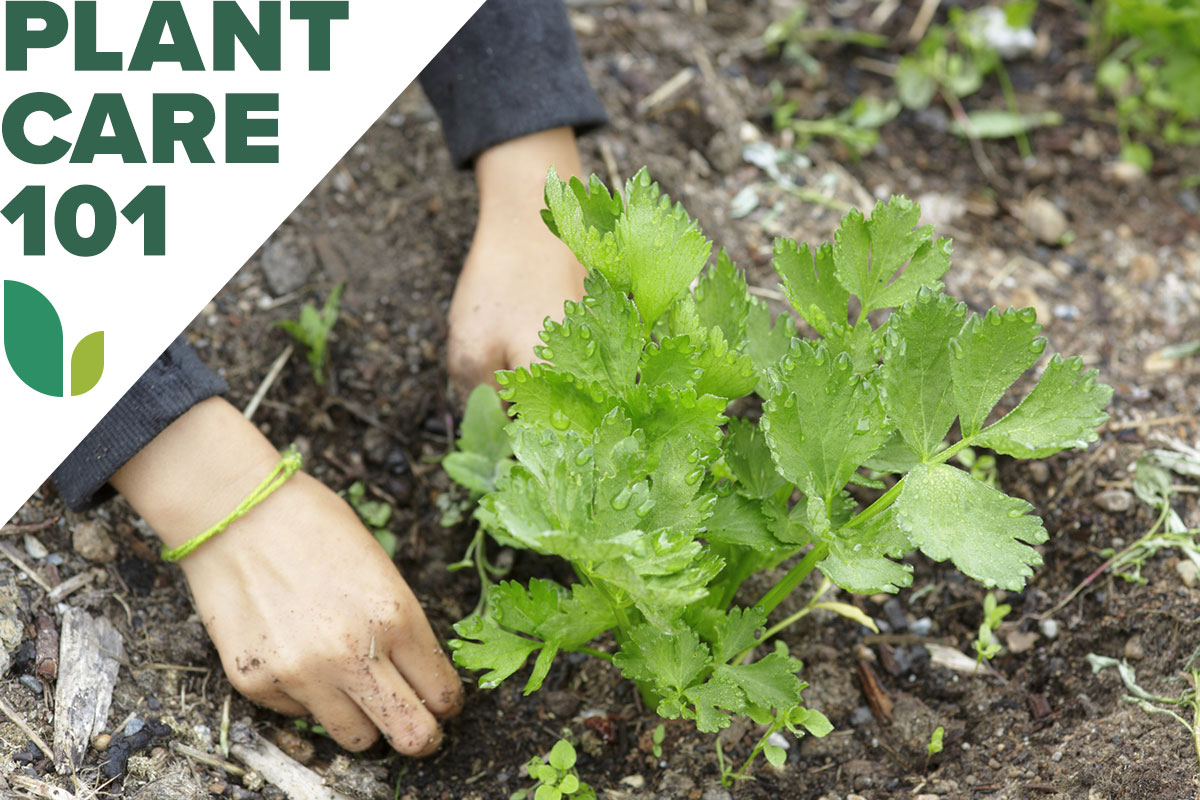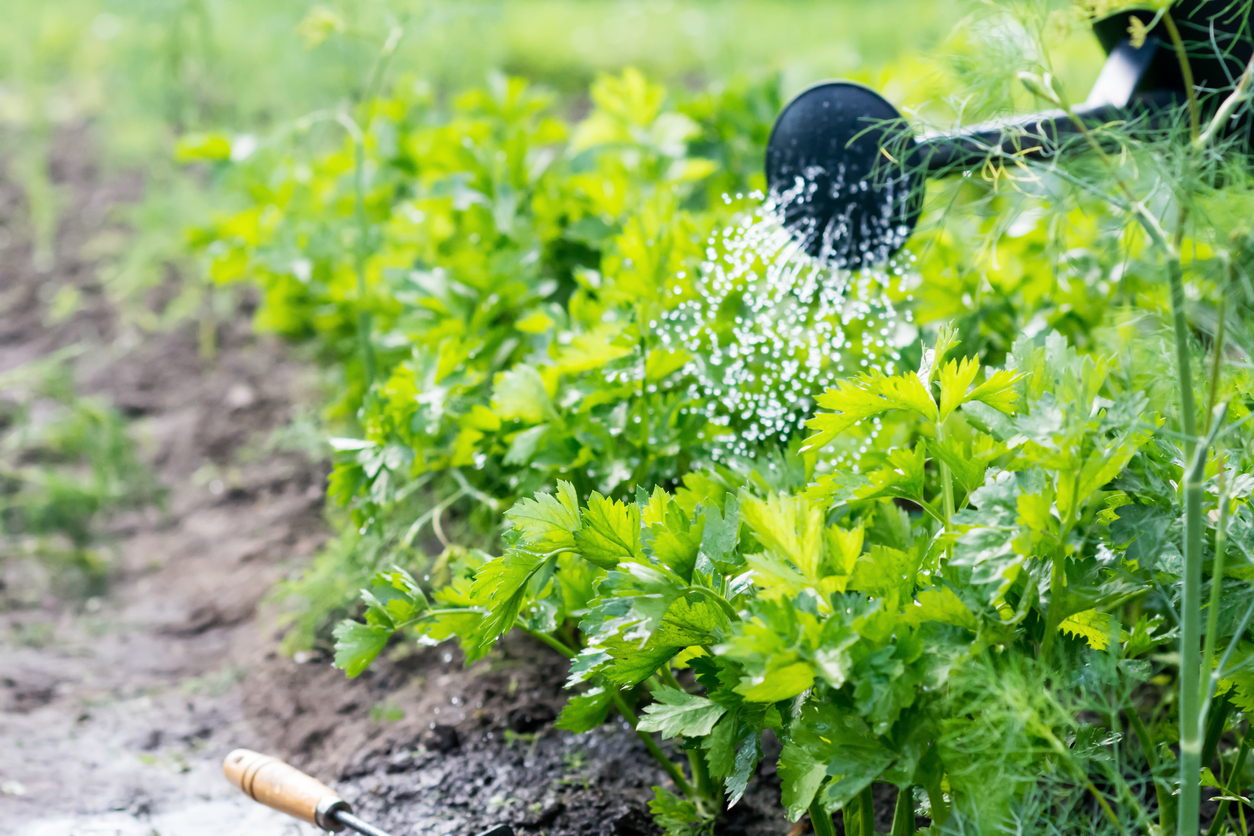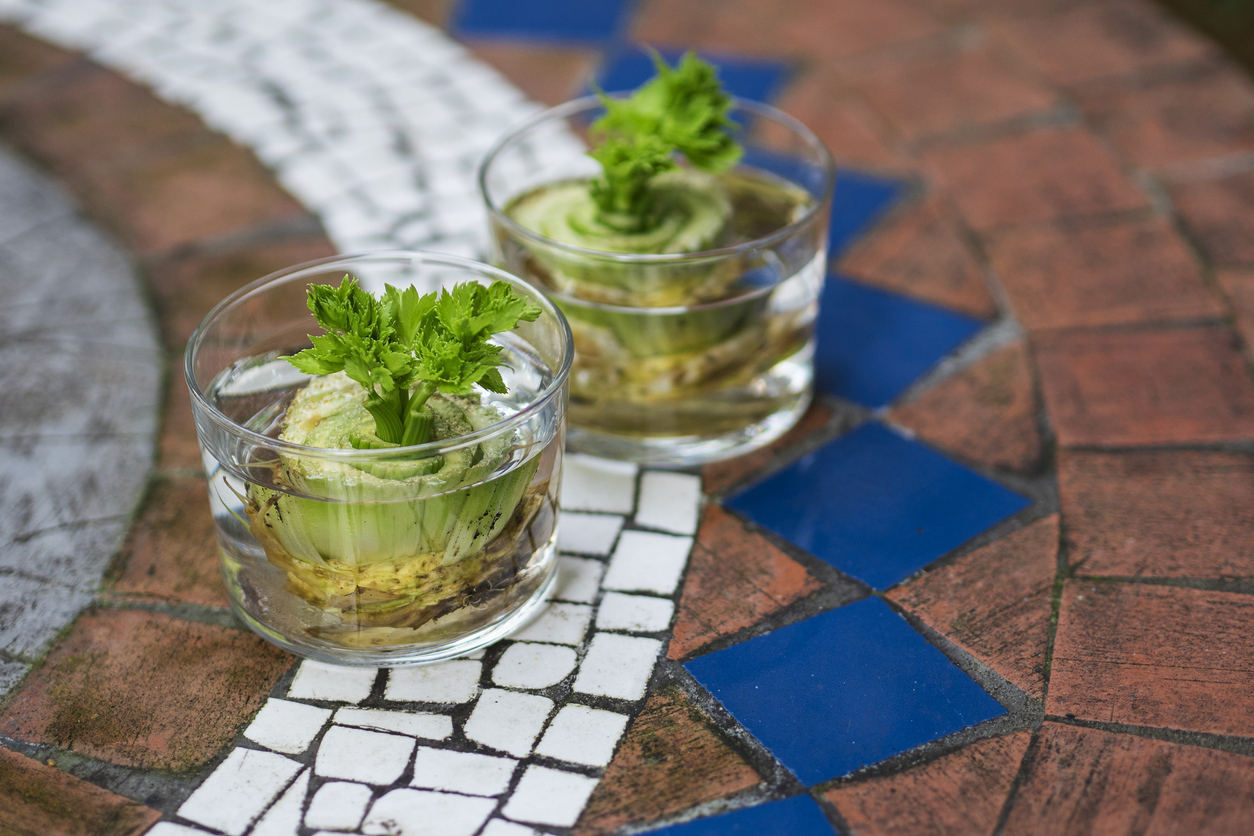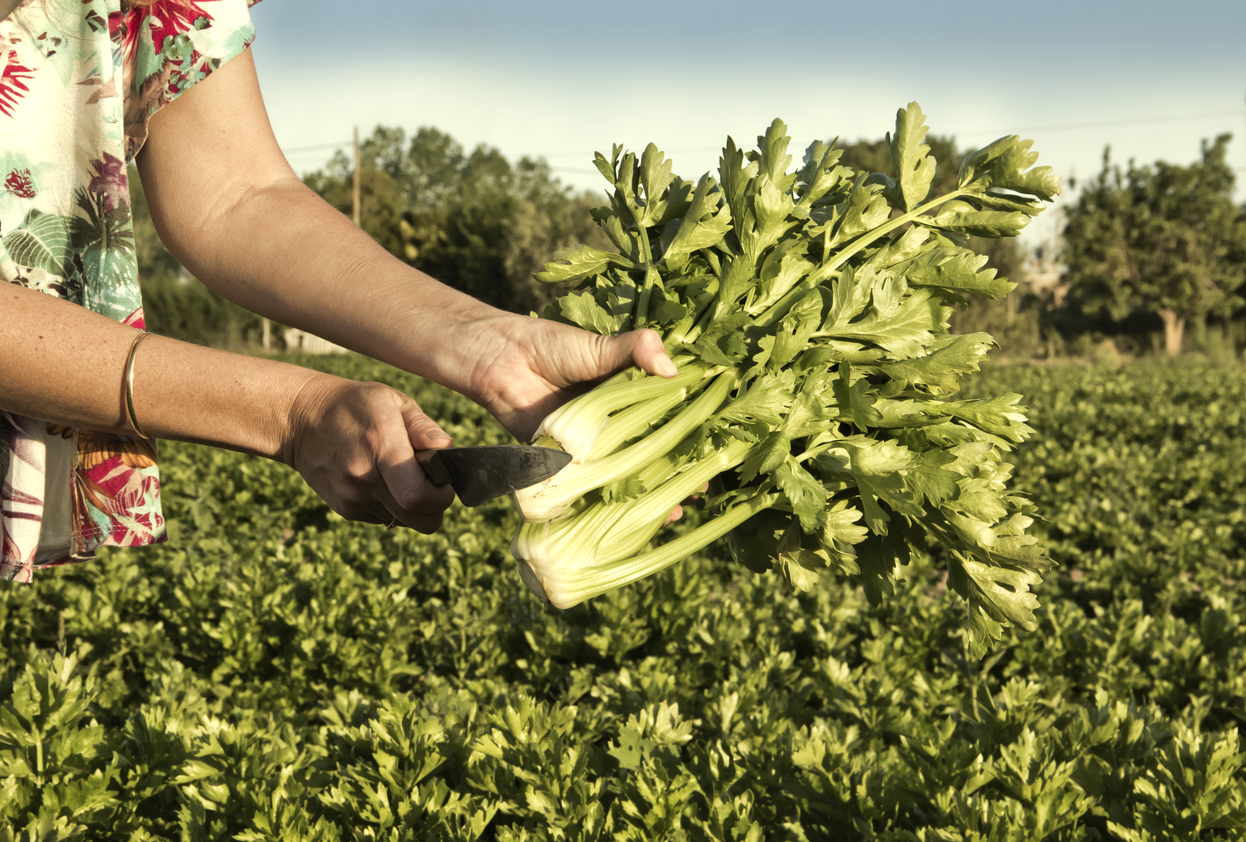

We may earn revenue from the products available on this page and participate in affiliate programs. Learn More ›
Celery is a healthy vegetable chock-full of antioxidants, fiber, and nutrients that reduce inflammation, lower blood pressure, and help prevent some illnesses and diseases. This low-calorie treat can be eaten raw or as an ingredient in a number of tasty dishes. Homegrown celery has more flavor than store-bought, which is also one of the most pesticide-contaminated types of produce sold.
Suited to a wide range of USDA growing zones, celery takes up little space in the garden and is a good companion plant, benefiting tomatoes, beans, cabbage, and more. It’s also easy to plant and harvest, so even gardening beginners will have a breezy time learning how to grow celery at home.
Growing Celery at a Glance
Common Name: Celery
Scientific Name: Apium graveolens
Hardiness Zone: 2 to 10
Soil: pH between 5.8 to 6.8, enriched with compost
Light: 6 to 8 hours of direct sunlight
Water: Constant moisture
Food: Side-dress with 10-10-10 fertilizer
Propagation: Seed or by rooting the base of the stalk
Safety: Possible allergic reactions, contact dermatitis from the leaves or juice

Celery Characteristics
Celery, aka Apium graveolens, is a biennial plant (although commonly grown as an annual) that requires a long, cool growing season. Part of the Apiaceae family, celery is related to carrots, parsley, cilantro, dill, and fennel—all aromatic herbs with hollow stems sprouting flat-topped clusters of leaves. A good source of vitamin K, its antioxidants start fading away about a week after cutting. Celery is native to Europe, the Mediterranean, and parts of Asia, where it was once used for medicinal purposes since it is known to promote sleep, detoxify the liver, soothe nerves, and provide support for the urinary tract.
Growing celery stalks (which reach between 12 and 18 inches tall) typically takes up to 140 days before they’re ready to harvest, so gardeners often start seeds indoors if their growing season is short.
Recommended Celery Varieties
There are three main types of celery: celeriac, celery leaf, and Pascal celery. Also known as stalk celery, Pascal celery is the most common type grown in the United States. Within that category, there are several varieties, a few of which include:
- Tango: A popular choice with gardeners, Tango grows withstands heat and moisture stress, matures in 80 days, and its tender stalks have a slightly sweet flavor and are less fibrous than other varieties.
- Golden Pascal: This French variety can withstand colder temperatures, has yellowish-green stalks without strings, is tender and juicy, and matures in 115 days.
- Giant Red: Growing up to 2 feet tall, it’s one of the largest varieties, but still matures in 85 days, has a robust flavor, and reddish-purple coloring.
- Monterey: This Spanish hybrid is dark green, grows to 12 inches, matures in 80 days, resists bolting, and is heat- and disease-resistant.
- Kelvin: A space-saving selection that does well under heat and moisture stress and in sub-par soil, this hybrid produces thick, juicy, flavorful stalks with a long hold time in the garden.
Planting Celery
Planting celery from seeds can be challenging because they take a while to germinate and can be finicky. However, with plenty of sun and moist soil, successful results can be achieved.
When is the best time to plant celery?
Because celery has such a long growing season, the best way to grow this vegetable is to plant seeds indoors 10 to 12 weeks before the last spring frost date in your area. When weather permits, the celery seedlings should be carefully transplanted in the garden between mid-May to early June in locations where summers don’t get too hot. Similarly, for a fall crop, seeds should be started 10 to 12 weeks before the first fall frost date.
Where can celery grow?
Celery grows best where it gets 6 to 8 hours of full, direct sunlight. If it is shaded by trees or structures or receives afternoon shade, it won’t thrive—unless your garden is in a hot desert climate. Celery grows best when temperatures are between 55 to 80 degrees Fahrenheit. If daytime temperatures are hotter than that, dappled shade is necessary, in which there is a mix of sun and shade. Additionally, the shallow roots of celery plants need rich, organic soil and constant water.
How do you plant celery?
When the soil temperature is at least 50 degrees Fahrenheit and nighttime temperatures stay above 40 degrees Fahrenheit, celery seedlings are ready to be transplanted into the garden. Follow these steps to plant celery:
- Make a series of trenches 4 inches to 6 inches deep and 12 inches to 24 inches apart.
- Use a trowel to make holes 6 inches to 10 inches apart, and place one plug in each.
- Backfill the soil, but do not tamp down.
- Water thoroughly since celery does not do well when dried out.
In hot climates, covering parts of celery plants with dirt to prevent photosynthesis can minimize any bitter flavor. Known as blanching celery, it produces a paler plant with fewer nutrients, but has a sweeter taste.
Can you grow celery in containers?
Growing celery indoors or in outdoor containers can be done. A container will need to be at least 8 inches deep and 12 inches wide and have a drainage hole. The plant should be placed where it will receive a minimum of 6 to 8 hours of sun.
The soil must be kept moist, but not soggy, which is sometimes a challenge for container-grown plants since they can dry out quickly in full sun. Fertilize every 2 weeks. Harvest when the stalks are 6 inches long.

Watering Celery Plants
Celery is a very thirsty plant, intolerant of drought. Because it’s 95 percent water by weight, this marshland plant needs an inch of water per week, particularly during hot weather. Without sufficient, consistent moisture, stalks will be small and dry, yields can be less, and flavor could suffer.
Drip lines and soaker hoses will help keep the soil consistently moist. In dry climates, adding 6 inches of mulch helps the soil retain moisture. Mulch also keeps the roots cooler because it can lower soil temperature by about 10 degrees Fahrenheit.
Fertilizing Celery
Celery is a heavy feeder that benefits from fertile, well-drained soil high in organic matter, as well as an all-purpose fertilizer applied every 4 to 6 weeks once the plants are 4 inches to 6 inches tall. Adding 2 inches to 4 inches of compost, decomposed manure, or leaf mold before planting amends the soil, enabling it to retain moisture and provide nutrients to the plant’s roots. A balanced fertilizer that has equal parts of nitrogen, phosphorus, and potassium is best; a 10-10-10 formulation is sufficient. Too much fertilizer results in tall, weak, disease-prone plants. Too little causes stunted growth, yellowing, and reduced vigor.

Propagating Celery
While celery is usually planted using seed, growing celery from scraps is also possible. Cut the base off a bunch of celery and place it in a shallow bowl of water out of direct sunlight. Within days, it should sprout.
“The main methods of growing celery from a stalk are either in water or soil,” says Jeremy Yamaguchi, CEO of Lawn Love. “Growing in soil is generally considered to be the better (and easier) option.”
Celery sprouted from scraps can be planted in pots or containers indoors or transplanted into the garden. “It will take about a month for celery to sprout from a stalk before it is ready for transplanting and then another 4 months until the plant has grown large enough to harvest,” Yamaguchi estimates.
Safety Considerations
While the stalk, leaves, and roots of celery are all edible, some people experience allergic reactions to psoralens, compounds produced by celery that increase the skin’s sensitivity to ultraviolet light. It only comes from raw celery—typically the leaves, but also from the juice. Contact dermatitis, or a rash, will develop within 12 to 36 hours and can last several days.
Psoralens also have a potentially carcinogenic effect. The toxins come from a fungus called pink rot, which causes brown patches. How does celery grow this toxin? Psoralens are naturally occurring, but commercially grown celery often harbors toxic chemicals from pesticides.
Potential Pests and Diseases
Celery is generally pest- and disease-free. However, when stressed, celery is susceptible to pathogens. Growing healthy plants during celery season is the best preventative measure.
Look out for aphids. These whitish-yellow, soft-bodied insects that hide on the underside of leaves or inner stalks secrete a sticky substance that can cause mold on celery.
Also, overhead irrigation can lead to Cercospora leaf spot or early blight, diseases that occur in warm temperatures on wet leaves. These spots can kill whole leaves or the entire plant. Bacterial blight produces spots that turn brown. It is particularly prevalent when temperatures are above 86 degrees Fahrenheit, and it spreads by water splashing or wind blowing.

Harvesting Celery
One of the advantages of growing your own celery is that you can harvest small amounts throughout the summer. The continuous harvest method extends the growing season by allowing you to take only as much as you need at any given time.
When is the best time to harvest celery?
Celery started indoors is usually ready to be harvested in mid-summer, or whenever the stalks reach about 8 inches tall. It’s possible to continue harvesting until autumn’s first frost if you’re using the continuous harvesting method of removing only a few stalks at a time rather than taking the entire plant. You’ll get higher yields and better regrowth this way. Young stalks are as good as mature stalks.
How do you harvest celery?
Removing only the outer stalks as needed prolongs the growing season, allowing you to harvest fresh celery when desired. Follow these steps to harvest celery:
- Use a sharp knife or scissors to remove the outer stalks as close to the soil line as possible.
- Cut cleanly to avoid leaving ragged edges that can provide shelter for pests and diseases.
- Whether you take one or all the stalks, leave the base. If the roots are undisturbed, they may grow back the following year, depending on the climate.
How do you store celery?
Celery is best used fresh, but if you have an abundance that you’re not ready to use, place it in a glass of water on your counter. Hydration is the key to prevent celery from going limp.
Alternatively, you can wrap a whole, uncut bunch of celery in aluminum foil, leaving the ends uncovered to allow the ethylene gas to escape. Place in the crisper drawer of your refrigerator; it should stay fresh for up to four weeks.
Looking for how to grow more vegetables? Check out our guides on growing cucumber, squash, and green beans.
